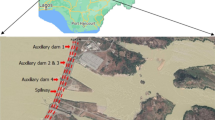Abstract
The main purposes of this study are to determine the fault position and possible crushed zones, general position and qualitative image of injection curtain, topology of cavities, and weak areas, and also examine deep extension of existing cracks in Berm. Geophysical examinations were performed by using the combination of electrical resistivity and microgravimetry data in Lar Dam. These studies include measurements of 420 electrical soundings with 1,000 m maximum length of current transmitter and measuring 1,081 microgravimetry stations. Also, in order to examine the possible density contrasts, this study discussed three-dimensional modeling by microgravimetry method to obtain Bouguer anomaly and residual anomaly, and determine the edge of residual anomaly. The result of these studies identified four crushed and weak areas with maximum water flight potential. Due to priority and importance degree of geological anomalies, these four weak areas are in the south part of the dam body, north of Berm, south of Berm, and west and southwest of Berm. The observed cracks in Berm are results of Berm subsidence that is due to fault activities or falling developed cavities along faults. It is presented that these cavities which are extended to depth of 70 m can have significant effect on the stability of the dam body.



















Similar content being viewed by others
References
Blakely RJ (1996) Potential theory in gravity and magnetic applications. Cambridge University Press, Cambridge, p. 441
Blakely RJ, Simpson RW (1986) Approximating edges of source bodies from magnetic or gravity anomalies. Geophysics 51:1494–1498
Bobatchev AA, Modin IN, Pervago EV, Shevnin VA (1997) TES technology for 2D resistivity sounding data processing, visualization and interpretation. MSU Press, East Lansing, p. 25
Camacho A (2000) Gravity inversion by means of growing bodies. Geophysics 65:95–101
Debeglia N, Corpel J (1997) Automatic 3-D interpretation of potential field data using analytical signal derivatives. Geophysics 62:87–96
Feghhy (2004) A study of water flight problem in Lar Dam using geological approach, Tehran Regional Water Organization Report
Griffiths DH, Barker RD (1993) Two dimensional resistivity imaging and modeling in areas of complex geology. J Appl Geophys 29:211–226
Loke MH (1999) RES2DINV, geoelectrical imaging 2D & 3D software user manual, v. 3.42
Loke MH, Barker RD (1996) Rapid least-squares inversion of apparent resistivity pseudo sections by a quasi-newton method. Geophys Prospect 44:131–152
Menke W (1989) Geophysical data analysis: discrete inversion theory, Academic, New York, p. 289
Miller HG, Singh V (1994) Potential field tilt—a new concept for location of potential field sources. J Appl Geophys 32:213–217
Plouff D (1976) Gravity and magnetic fields of polygonal prisms and application to magnetic terrain correction. Geophysics 41:727–741
Sasaki Y (1992) Resolution of resistivity tomography inferred from numerical simulation. Geophys Prospect 54:453–464
Schulz R, Tezkan B (1988) Interpretation of resistivity measurements over 2D-structures. Geophys Prospect 36:962–975
Verduzco B, Fairhead D, MacKenzie C (2004) New insights into magnetic derivatives for structural mapping. SEG's The Leading Edge, pp. 116–119
Author information
Authors and Affiliations
Corresponding author
Rights and permissions
About this article
Cite this article
Asl, M.M., Pour, H.J. & Mehramuz, M. Detection of faults position and possible crushed zones by using electrical resistivity and microgravity methods: Application to the Lar Dam area, Iran. Arab J Geosci 8, 1497–1512 (2015). https://doi.org/10.1007/s12517-013-1214-9
Received:
Accepted:
Published:
Issue Date:
DOI: https://doi.org/10.1007/s12517-013-1214-9




